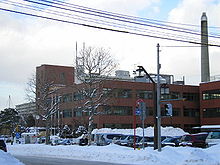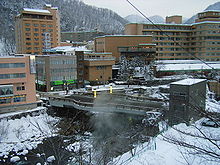- Minami-ku, Sapporo
-
Minami-ku, Sapporo (南区、札幌) is one of the 10 wards in Sapporo, Hokkaidō, Japan. Minami-ku is directly translated as "south ward". Having the area of 657.23 km² in total, Minami-ku occupies 60 percent of the area of Sapporo.[1]
Contents
Overview
According to the jūminhyō (registry) in 2008, 149,139 people were living in Minami-ku. The total area of the ward is 657.23 km²,[2] which is the largest in Sapporo. 17 mountains including Mount Yoichi (1488.1 metres, the highest mountain in Sapporo)[1] are included in the ward, along with part of the Shikotsu-Tōya National Park.
Sapporo's five wards: Chūō-ku, Toyohira-ku, Kiyota-ku, Nishi-ku, Teine-ku, have boundaries with Minami-ku, and four cities (Chitose, Otaru, Date, Eniwa) , two towns (Yoichi, Kyōgoku) , and a village (Akaigawa) also have boundaries.
History
Originally, the area where currently Minami-ku is located has been famous for the hot springs in Jōzankei area and mines in Ishiyama area, and many pioneers and their families have settled from the outside of Hokkaidō. In 1918, the Jōzankei Railroad was opened for traffic from Shiroishi area to current Minami-ku area. In 1946, after the end of World War II, American army took over farms in Makomanai area, and built the military camps called "Camp Crowford".[3]
The restoration of the Camp Crowford began in 1955, and camps of the Japan Ground Self-Defense Force were started to build. In 1972, Sapporo Winter Olympics was held in Sapporo, and a number of sports competitions were held in Makomanai area, including biathlon, cross-country skiing, figure skating, ice hockey, and the cross-country skiing portion of the nordic combined events.[4] In the same year, Sapporo was listed as one of the cities designated by government ordinance, and Minami-ku was established.[3] The camp of the Self-Defense Force has been one of the venues of the Sapporo Snow Festival, however, it was abolished and moved to the Sapporo Satoland site located in Higashi-ku, in 2005.
Points of interest
- Jozankei hot springs resort - a number of hotels and resorts with hot springs.
- Makomanai Park - a park including the Makomanai Ice Arena, Makomanai Open Stadium, and Sapporo Salmon Museum.
- Sapporo Art Park - a park with many public arts.
- Monami Park - a park including a mine of the Sapporo Nanseki (soft stone).
Sources
External links
- Minami-ku, official homepage (Japanese)
Venues of the 1972 Winter Olympics City venues Makomanai Biathlon site • Makomanai Cross-country site • Makomanai Ice Arena • Makomanai Speed Skating Rink • Mikaho Indoor Skating Rink • Tsukisamu Indoor Skating RinkMountain venues 1924 (military patrol): Stade Olympique de Chamonix • 1960: McKinney Creek Stadium • 1964: Seefeld • 1968: Autrans • 1972: Makomanai Biathlon site • 1976: Seefeld • 1980: Lake Placid Olympic Sports Complex Cross Country Biathlon Center • 1984: Igman, Veliko Polje • 1988: Canmore Nordic Centre • 1992: Les Saisies • 1994: Birkebeineren Skistadion • 1998: Nozawa Onsen Ski Resort • 2002: Soldier Hollow • 2006: Cesana San Sicario • 2010: Whistler Olympic Park • 2014: Biathlon & Ski Complex 1924: Stade Olympique de Chamonix • 1928: Around the hills of St. Moritz • 1932: Lake Placid • 1936: Große Olympiaschanze • 1948: Around the hills of St. Moritz • 1952: Holmenkollen National Arena • 1956: Lo Stadio della neve • 1960: McKinney Creek Stadium • 1964: Seefeld • 1968: Autrans • 1972: Makomanai Cross-country site • 1976: Seefeld • 1980: Lake Placid Olympic Sports Complex Cross Country Biathlon Center • 1984: Igman, Veliko Polje • 1988: Canmore Nordic Centre • 1992: Les Saisies • 1994: Birkebeineren Skistadion • 1998: Snow Harp • 2002: Soldier Hollow • 2006: Pragelato Plan • 2010: Whistler Olympic Park • 2014: Biathlon & Ski Complex
1924: Stade Olympique de Chamonix • 1928: Around the hills of St. Moritz • 1932: Lake Placid • 1936: Große Olympiaschanze • 1948: Around the hills of St. Moritz • 1952: Holmenkollen National Arena • 1956: Lo Stadio della neve • 1960: McKinney Creek Stadium • 1964: Seefeld • 1968: Autrans • 1972: Makomanai Cross-country site • 1976: Seefeld • 1980: Lake Placid Olympic Sports Complex Cross Country Biathlon Center • 1984: Igman, Veliko Polje • 1988: Canmore Nordic Centre • 1992: Les Saisies • 1994: Birkebeineren Skistadion • 1998: Snow Harp • 2002: Soldier Hollow • 2006: Pragelato Plan • 2010: Whistler Olympic Park • 2014: Biathlon & Ski Complex 1924: Le Tremplin Olympique du Mont, Stade Olympique de Chamonix • 1928: Around the hills of St. Moritz, Olympiaschanze St. Moritz • 1932: Intervales Ski-Hill, Lake Placid • 1936: Große Olympiaschanze • 1948: Around the hills of St. Moritz, Olympiaschanze St. Moritz • 1952: Holmenkollen National Arena • 1956: Lo Stadio della neve, Trampolino Italia • 1960: McKinney Creek Stadium, Ski jumping hill • 1964: Seefeld • 1968: Autrans • 1972: Makomanai Cross-country site, Miyanomori Jumping Hill • 1976: Seefeld • 1980: Intervales Ski-Hill, Lake Placid Olympic Sports Complex Cross Country Biathlon Center • 1984: Igman, Malo Polje; Igman, Veliko Polje • 1988: Canada Olympic Park (includes bobsleigh/luge track), Canmore Nordic Centre • 1992: Courchevel • 1994: Birkebeineren Skistadion, Lysgårdsbakkene Ski Jumping Arena • 1998: Hakuba Ski Jumping Stadium, Snow Harp • 2002: Soldier Hollow, Utah Olympic Park (includes bobsleigh, luge, and skeleton track) • 2006: Pragelato, Pragelato Plan • 2010: Whistler Olympic Park • 2014: Biathlon & Ski Complex, Russian National Ski Jumping Centre
1924: Le Tremplin Olympique du Mont, Stade Olympique de Chamonix • 1928: Around the hills of St. Moritz, Olympiaschanze St. Moritz • 1932: Intervales Ski-Hill, Lake Placid • 1936: Große Olympiaschanze • 1948: Around the hills of St. Moritz, Olympiaschanze St. Moritz • 1952: Holmenkollen National Arena • 1956: Lo Stadio della neve, Trampolino Italia • 1960: McKinney Creek Stadium, Ski jumping hill • 1964: Seefeld • 1968: Autrans • 1972: Makomanai Cross-country site, Miyanomori Jumping Hill • 1976: Seefeld • 1980: Intervales Ski-Hill, Lake Placid Olympic Sports Complex Cross Country Biathlon Center • 1984: Igman, Malo Polje; Igman, Veliko Polje • 1988: Canada Olympic Park (includes bobsleigh/luge track), Canmore Nordic Centre • 1992: Courchevel • 1994: Birkebeineren Skistadion, Lysgårdsbakkene Ski Jumping Arena • 1998: Hakuba Ski Jumping Stadium, Snow Harp • 2002: Soldier Hollow, Utah Olympic Park (includes bobsleigh, luge, and skeleton track) • 2006: Pragelato, Pragelato Plan • 2010: Whistler Olympic Park • 2014: Biathlon & Ski Complex, Russian National Ski Jumping Centre Categories:
Categories:- Minami-ku, Sapporo
- 1972 Winter Olympics venues
- Olympic biathlon venues
- Olympic cross-country skiing venues
- Olympic nordic combined venues
- Wards of Sapporo
Wikimedia Foundation. 2010.



